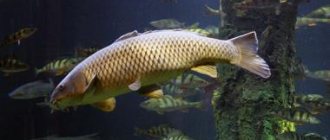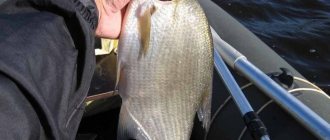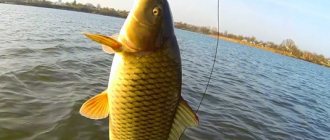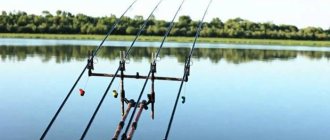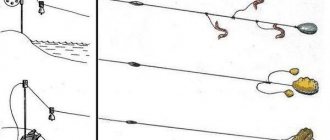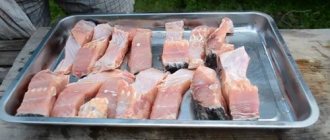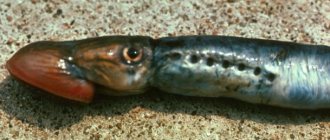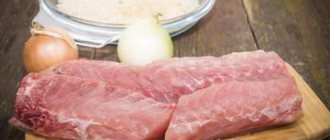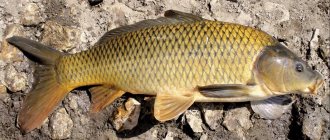Fishing places
As the water warms up, the carp rises from its wintering holes. Its bite begins when the water warms up to 10-12 degrees. At this time, it is not yet so active, so fishing is more sporadic. Stability occurs at a temperature of 15-16 degrees. In spring, it is better to look for carp in the following areas:
- Small shallow tributaries
- Areas with a clay bottom, near snags
- Shallow water next to reed thickets
- Near the islands of thickets
- Hard bottom areas where zebra mussels live
An easy way to find a school of fish is to arrive at the reservoir in the pre-dawn hours - in warm weather, carp often walks near the surface, revealing itself with splashes. After dawn, it moves to a depth where the tackle needs to be thrown. Most often, fishing occurs at depths of 3-4 meters.
How does spring carp behave?
After freeze-up, the carp spends some time in deep wintering holes, but with a gradual increase in water temperature, the fish swims closer to shallow waters in search of food. It is at this moment that you should catch this large and strong fish.
The carp leaves for spawning quite late. Only when the water is warm enough (at least 15 degrees). At this time, the fish is busy with the process of spawning, and therefore reacts very weakly to the proposed lures and baits.
After spawning, the carp returns to its places of deployment and moves away from the shore. Now the tactic of long casts with preliminary feeding of the fishing point brings good results. There is a change in the food preferences of fish. If before spawning she preferred organic food, then later she likes plant food.
Tackle
For spring fishing for carp, a float rod and a feeder are used. Given the specifics of fishing, the feeder is used most often.
Feeder
The feeder equipment looks like this:
- Rod, 4 meters long, with dough up to 100-120 grams
- Powerful reel, size 5000-5500 with gear ratio 4.1:1 -4.5:1, preferably a baitrunner
- Mono line, diameter 0.3-0.35 mm
- Leash made of mono fishing line, diameter 0.24-0.28 mm
- Hooks 10-12 numbers
Installations are used based on your own preferences, mainly a symmetrical loop or paternoster.
Feeders for the feeder are selected based on the presence and strength of the current. For calm water, cylindrical plastic feeders are used. For fishing in the middle reaches - metal feeders. For fishing in areas with strong currents - weighted metal feeders.
Float tackle
It makes sense to fish with float tackle if the carp stays close to the shore, which is more typical in the first half of spring. In its design it looks like this:
- Rod, 5-6 meters long
- Reel 4000-4500 with baitrunner
- Mono line, diameter 0.28-0.3 mm
- Leash made of fishing line, thickness 0.2-0.22 mm
- Float with long antenna
- Several pellet sinkers
- Hook 12-14 numbers
Which type of float tackle to use depends on the fishing conditions. For example, you can use regular fly rods, provided they are strong enough.
For fishing in the current, Bolognese tackle is better suited. It will help to carefully float the bait downstream, guiding it along the probable locations of the fish.
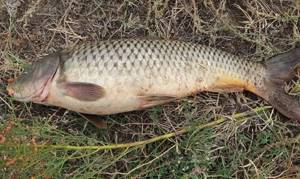
In conditions of limited space, a plug rod is the best solution. In addition, they allow you to silently deliver bait using a special bowl.
When the carp moves away from the shore, match gear is used. They allow you to easily make long casts, which is especially important closer to summer.
Techniques and Tactics of Catching Carp in Spring
In order for fishing for carp in the spring to be successful, you need to prepare for it in advance. To do this, prepare the bait and select a suitable attachment. All this allows you to cut off the bite of small fish.
Catching Carp In spring, it begins with baiting the chosen place. This process allows you to attract and keep fish at a certain point in the reservoir.
Of course, you can buy a fine-grained mixture at the store for bait, but then you won’t be able to avoid bites from small fish. Therefore, it is most often prepared independently. To do this, use various porridges, breadcrumbs and heavily boiled grains.

The best bait is considered to be a mixture consisting of solid components that are mixed with soil taken near the reservoir. It should be based on ingredients that will subsequently be used as bait.
This can be steamed corn, peas, beans, soybeans and boiled potato pieces. They can be mixed with chopped boilies and liquid attractants can be added.
Balls are made from bait, the density of which depends on the intensity of the current in the selected area. If they have a crumbly structure and are intended for fishing in still water, then they must be cast about an hour before fishing.
Dense balls are created for bait on the current or for long-term fishing. They need to be thrown into a pond in the evening or at night in order to start fishing at dawn.
Animal baits can also be used as bait for carp in the spring, but they can attract predatory fish. Therefore, it is advisable to choose a place where there is no outlet.
Bait for Carp can be a bunch of worms. Maggots, fried shellfish meat, chafer larvae, dragonflies and other insects are also used.
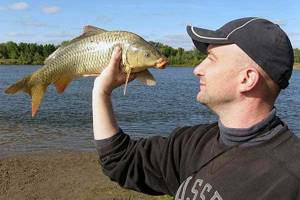
Lures
In spring, carp prefers animal baits:
- Maggot
- Muckworm
- Crawling out
- Perlovitsa
- Boilies based on animal ingredients (fish, shrimp)
Only later, closer to summer, when the water warms up sufficiently, he begins to be interested in plant baits:
- Corn
- Boilies based on plant components
- Pearl barley
- Potato
- Cake
- Mastyrka
Carp are more willing to bite on large bait; you can experiment with combinations of different baits.
Fishing in May
We will divide our story about carp fishing into four parts according to the months of fishing, starting, naturally, from May, the first month of open water fishing. Let's take a little time to the end of April; ichthyologists, describing this fish, indicate that carps begin to show their first activity when the water temperature reaches 10-11 degrees. This exactly coincides with the end of the second spring month for the middle zone, and even earlier for the southern regions.
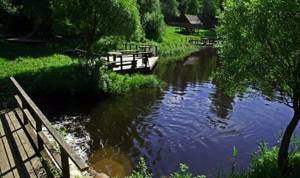
In May, carp begin to gather in flocks and move to future spawning grounds. That is why it is better not to look for fish in a reservoir, but to collect them at the fishing point with bait. However, for even more successful fishing you will need bait, preliminary feeding of the place over the last two to three days.
In May, it is better to use bottom gear for catching carp, because float gear is less effective in this regard due to the high rise of water and the irregular presence of fish at typical points.
Among the bottom fishing rods, it is necessary, first of all, to highlight the following:
- donka with a reel;
- feeder;
- carp rod.
Zakidushki and elastic bands are used less frequently, the former, in principle, disappear from the arsenals of modern fishermen, and the latter are too tied to the place and do not have the necessary mobility in the spring to successfully catch fish walking throughout the reservoir.
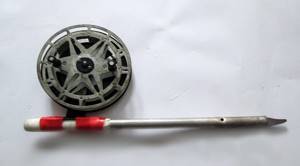
Although carp is considered an omnivorous fish, when fishing in May it is preferable to use animal bait, since the fish is just recovering from a winter half-starved lifestyle, and even more so is preparing for reproduction, and protein food comes in handy here. Sometimes in May they also use vegetable baits such as semolina dough or pearl barley, but “meat” works better. You can catch wild carp at this time using the following baits:
- bunch of bloodworms;
- several maggots;
- two or three dung worms or one earthworm, wearing rings;
- pearl barley;
- dragonfly larva;
- medium-sized boilies with a meat or fish aroma.
In general, during preparation for spawning, when the bellies of the fish are filled with caviar and milt, it is undesirable to use large fractions; the mouth of a large piece of carp, contrary to the saying, is not very happy; in May it is better to fish with small baits.
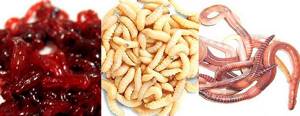
As noted above, it is better to carry out feeding for a long time, using baits. In this case, you need to use the same compositions without changing them on the day of actual fishing. The flavoring of mixtures should be carried out with compounds of natural origin or alcohol-based attractants, and the direction of odors should be meaty or spicy.
As for the time of day and weather, in spring it is best to fish in the morning of a sunny day or in the evening in good calm weather. Any bad weather will have a negative impact on fish, which are finicky at this time of year.
Fishing tactics
In spring, the behavior of carp changes dramatically, which is explained by warming and the subsequent spawning.
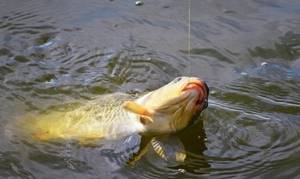
Therefore, depending on the month, fishing tactics will have its own characteristics.
March
In March, even if the ice has already melted, carp can hardly be caught anywhere. The only exception will be the southern regions with a warm climate, where the water has time to warm up to the required temperatures. The activity of the fish is extremely low, it moves little, so it is necessary to fish in deep areas.
Only animal baits are used; there is no particular point in baiting.
April
April is a completely different matter, when the water warms up, the carp approaches the shore and begins to feed intensively before spawning. They fish not only with animal baits, but also with plant baits, and use bait in large quantities.
This period is perhaps the most interesting for those who like to catch carp. First of all, this is a variety of baits, the opportunity to experiment, and besides, the carp stays nearby, which makes fishing much easier.
May
In May, carp begin to spawn. During this period, fishing is prohibited; specific dates are designated for each region. Typically, spawning lasts no more than two weeks, after which the fish return to their usual places in the depths.
Here the best option would be feeder fishing. Over the course of several days, baiting is carried out, which makes fishing more effective.
You can do without attachment by simply feeding several likely areas in advance.
Keep in mind that after spawning the carp is active for about a week, then its bite begins to decline.
Ammunition for fishing for carp
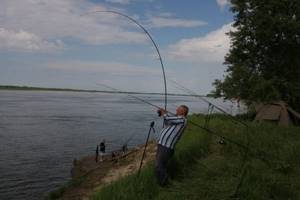
Naturally, the fishing rod must be powerful, even oak. If we are talking about a float rod, then its optimal length is from 7 to 10 meters. Test rods from 8 grams, since you will have to cast heavy floats.
A feeder rod for catching carp is used with dough from 150 grams. Heavy and extra-heavy rod type, length from 3.9 to 4.7 meters. It is better to use special carp rods. They are installed on the rod pod and placed on the signaling device. Nowadays there are many modifications of alarms on sale. There are remote ones that will wake up a fisherman sleeping in a tent or car; they use conventional sound and light.
The reels are placed with a baitrunner, since the carp does not take up the strength. It doesn’t take much effort for him to drag the fishing rod with him. Spool volume for reels from 5000. Hooks are used with thick wire numbers 4-6 according to the international classification.
In the spring, we definitely add chopped worms, bloodworms and maggots to the bait. If you feed him only bread, then he will not understand you well, and will simply go to another fisherman who can serve him meat, suitable dishes. The task of this fish at the end of spring is to eat heavily before spawning. The fisherman's task is to serve him so much food that he constantly spins in the fishing spot. The basic basis of bait for carp and carp has always been makha (necessarily fresh and good-smelling), grains (peas, corn, pearl barley), pellets, compound feed and boilies. The essence of fishing for carp is the same in both summer and spring: the one who feeds the most catches these fish.
General information about fishing for carp
This fish is a representative of the carp family. It is far from simple. To be more precise, carp is a “wild” carp that, instead of ponds and fish farms, lives in rivers and lakes. Even experienced fishermen cannot always boast of catching trophy specimens. Carp is a very shy inhabitant of the underwater world; moreover, it is secretive and very careful. Finding its feeding places can sometimes be difficult. However, those who at least once in their lives had the opportunity to measure their strength with a huge carp, and then hold it in their hands, feeling its weight, again and again look for a meeting with this giant. And this is not surprising: sometimes fishermen come across specimens weighing thirty kilograms.
July
You can catch carp in July in the same places as in the previous month. In addition, the most important factor in midsummer is the thermocline - the stratification of water into zones with different temperatures. From the shore it is completely impossible to understand at what depth the cool layer, favorable for finding fish, is located. For rivers, this factor is less important, but even here the carp begins to be capricious.
Successful fishing is now guaranteed only in the deepest parts of the reservoir, provided that there is a carp there. Finding such a point is the main task for the carp hunter in July.
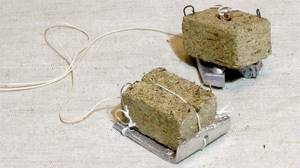
In July, carp are often caught using surface gear - “crust of bread”. It can be used both for fishing near the shore near thickets of vegetation, and at a distance from the water's edge. Then a tackle with a feeder float is used.
It is interesting to use another specific tackle in July - a makushatnik. A piece of fresh sunflower cake with a sinker thrown at the desired point in the reservoir literally drives carp crazy.
As for baits and baits, in July they use the same things as for June fishing.
catchable places
The most effective time is April, when rivers and reservoirs are warm enough. At this time, the most promising places are clay edges near steep yars, as well as holes with snags, where the current is opposite. Areas for catching carp these spring days need to be chosen wisely. The main factor determining the catchability of a place is the possibility of positioning the gear under the edge.
Fishing for carp in the spring on the Volga, especially in April, is very good. It is easy to find: with the onset of dawn, this fish splashes almost on the surface of the water. While playing, she herself shows where she lives. Sometimes the carp splashes powerfully even at night, giving away its location.
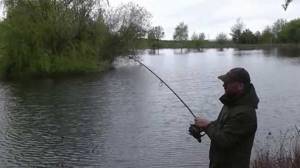
Having found such places, the fisherman must remain silent: the carp is very careful. This fish likes to lie on the muddy bottom, so if the bait doesn’t reach the bottom, it simply won’t take it.

